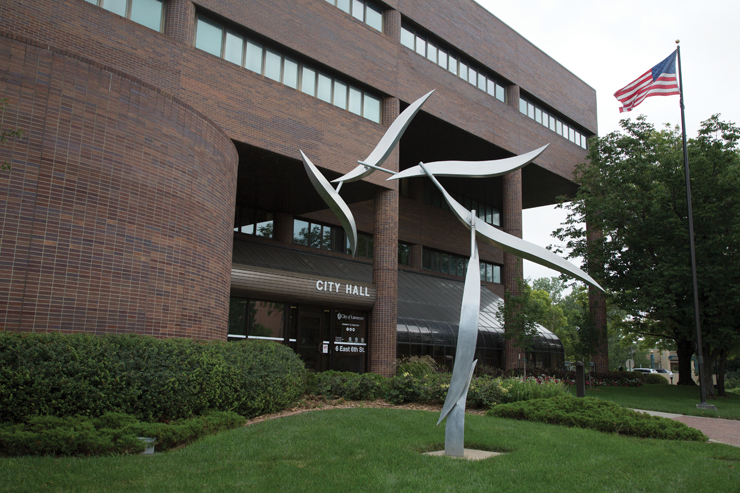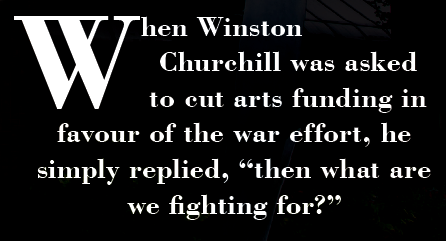Arts and Culture – A Civic Catalyst.
| 2016 Q3 | story by PORTER ARNIELL, Director of Arts & Culture for the City of Lawrence
| photo by Steven Hertzog

Lin Emery’s kinetic aluminum sculpture “Flame” stands in front of City Hall
Art and aesthetics have been integral to humanity since the dawn of time. From tribal cave paintings to Egyptian pyramids to the prodigious artwork of the Italian Renaissance and beyond, the arts have been part of civic infrastructure throughout history, highlighting the civic and cultural identity of innumerable civilizations.
Civic arts & culture programming and financing in the U.S. can be traced back to between 1890 through 1910 when both the City Beautiful and Village Improvement Movements thrived in the U.S. These civic planning organizations were created in response to prolific immigration and the many burgeoning towns and cities with populations of 2500 or more that were rapidly dotting the United States. In 1900, there were over 3000 of these groups across the U.S. Proponents of these movements, like Frederick Law Olmsted, recognized that the underlying philosophies of urban/suburban beautification and community arts programming were helpful in promoting civic engagement, social harmony, safety, and improved quality of life. The rationale of creating “Great Cities” through excellent design and unique cultural amenities gained popularity and often earned support from American business owners who wanted to share their good fortune and create a lasting legacy for their community.

Coincidentally, beginning around 1900 in response to immigration and rapid civic growth, social reform efforts became increasingly popular. Settlement Houses were created to help immigrants transition into American life. From the Settlement House movement grew what is known today as the Association of Junior Leagues International, Inc. (AJLI)—a non-profit organization that provided opportunities for women to volunteer to improve communities. In time, to catalog and help quantify the remarkable range of ongoing arts programming in communities, Virginia Lee Comer, the Senior Consultant for Community Arts for the Junior League, conducted community inventories for arts programs, which spawned and evolved into the “Local Arts Agency” or LAA.
A range of civic arts and culture programs unfolded in the U.S. over the following decades. Among them were:
• 1935 – 1943 – During the Great Depression, the Works Progress Administration (WPA) Federal Art Program employed more than 6,000 artists who create more than 2,000 murals, 17,000 sculptures and 100,000 paintings which adorn many federal buildings/sites.
• 1959 – Philadelphia passed the first one percent for art ordinance in the United States (there are now more than 400 similar programs)
• 1965 – The National Endowment for the Arts was established
• 1972 – The Government Services Administration (GSA) established the Art in Architecture program for Federal buildings
• 1973 – 1982 – The Comprehensive Employment and Training Act (CETA) an extension of the WPA program which also employed many artists to create public works over a nine year period.
In 1996, Americans for the Arts was established as the result of a merger between the National Assembly of Local Arts Agencies (NALAA) and the American Council for the Arts (ACA). And, in-step with history, in 2005, Americans for the Arts merged with the Arts & Business Council Inc. whose mission is “To develop more creative partnerships between the arts and business communities.”
Today there are more than 400 municipal arts & culture offices in cities and counties across the U.S. In addition to implementing a range of art & culture programs, these agencies are aligning with other city agencies and private entities to collaborate on convention and visitor experiences, sustainability, and economic and community development.
In Lawrence, the Cultural Arts Commission is working with Americans for the Arts on a national arts and economic impact research project for the city and Douglas County. They are also working with eXplore Lawrence to help promote the city-wide cultural plan in concert with Unmistakably Lawrence.
As the renowned composer Modest Mussorgsky said, “Art is not an end in itself, but a means of addressing humanity.”
